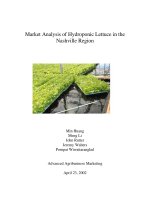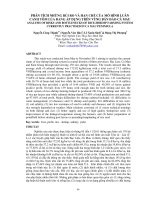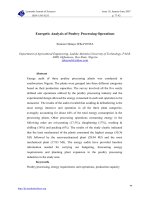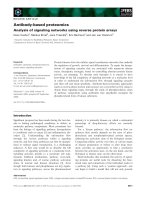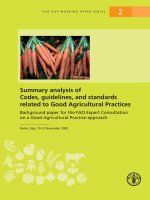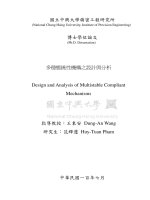LCMS MS based metabolome analysis of babylonia
Bạn đang xem bản rút gọn của tài liệu. Xem và tải ngay bản đầy đủ của tài liệu tại đây (543.33 KB, 8 trang )
link.springer.com
LC–MS/MS-Based Metabolome Analysis of
Biochemical Pathways Altered by Food
Limitation in Larvae of Ivory Shell,
Babylonia areolata
AuthorsAuthors and affiliations
17-22 phút
Jingqiang Fu
Minghui Shen
Yawei Shen
Wengang Lü
Miaoqin Huang
Xuan Luo
Jinjin Yu
Caihuan Ke
Weiwei You
Jingqiang Fu
o 1
o 2
Minghui Shen
o 1
o 2
o 3
Yawei Shen
o 1
o 2
Wengang Lü
o 4
Miaoqin Huang
o 1
o 2
Xuan Luo
o 1
o 2
o 5
Jinjin Yu
o 1
o
2
Caihuan Ke
o 1
o 2
o 5
Weiwei You
o 1
o 2
o 5
Email authorView author's OrcID profile
1. 1.State
Key
Laboratory
of
Marine
Environmental
ScienceXiamen
UniversityXiamenPeople’s Republic of China
2. 2.College of Ocean and Earth SciencesXiamen UniversityXiamenPeople’s Republic of
China
3. 3.Tropical Marine Products Fine Breed CenterHainan Academy of Ocean and Fisheries
SciencesHainanPeople’s Republic of China
4. 4.College of FisheriesGuangdong Ocean UniversityZhanjiangPeople’s Republic of China
5. 5.Fujian Collaborative Innovation Center for Exploitation and Utilization of Marine
Biological ResourcesXiamenPeople’s Republic of China
Original Article
First Online: 20 April 2018
Abstract
Ivory shell, Babylonia areolata, is one of the commercially important mariculture species in
China and South East Asia. Survival varies in the artificial hatching and larval rearing of B.
areolata. Food deprivation may be involved in rearing mortality, and so, a better understanding
of how larvae respond and adjust to starvation is needed. In this study, the metabolite profiles of
newly hatched larvae with yolk (I), larvae with yolk exhaustion (II), larvae suffering 24 h
starvation after yolk exhaustion (III), and larvae fed with exogenous nutrients after yolk
exhaustion (IV) were analyzed by LC–MS/MS. Principal component and cluster analyses
revealed differential abundance of metabolite profiles across groups. When compared to
metabolite levels of the I group, significantly up-regulated metabolites included polyunsaturated
fatty acids, phospholipids, nucleotide, amino acids, and their derivatives were found in the II
group, indicating that organisms relied predominantly on glycerophospolipid metabolism and
protein-based catabolism for energy production during this stage. During starvation after yolk
exhaustion, the levels of all energy related metabolites were significantly reduced, but an
increase in products of purine and pyrimidine metabolism indicated an insufficient energy supply
and an increase in cellular disintegration. Larvae fed exogenous nutrients can have significantly
improved metabolism compared to starved larvae. These findings suggest that metabolomics,
using LC–MS/MS, can be used to assess the physiological status and food-affected metabolic
changes affecting B. areolata larvae.
Keywords
Babylonia areolata LC–MS/MS Metabolomics Newly hatched larvae Food limitation
This is a preview of subscription content, log in to check access.
Notes
Acknowledgements
The authors thank the Hainan Academy of Ocean and Fisheries Sciences for its assistance in
operations over the larval periods. This research was supported by the Earmarked Fund for
Modern Agro-industry Technology Research System (No. CARS-48) and the Hainan Provincial
Ocean Basic Budget Project in 2016.
References
1. Alfaro AC, Young T (2016) Showcasing metabolomic applications in aquaculture: a
review. Rev Aquac 0:1–18Google Scholar
2. Baniasadi H, Vlahakis C, Hazebroek J, Zhong C, Asiago V (2014) Effect of environment
and genotype on commercial maize hybrids using LC/MS-based metabolomics. J Agric
Food Chem 62:1412–1422CrossRefPubMedGoogle Scholar
3. Benton HP, Ivanisevic J, Mahieu NG, Kurczy ME, Johnson CH, Franco L, Rinehart D,
Valentine E, Gowda H, Ubhi BK, Tautenhahn R, Gieschen A, Field MW, Patti GJ,
Siuzdak G (2015) Autonomous metabolomics for rapid metabolite identification in global
profiling. Anal Chem 82:884–891CrossRefGoogle Scholar
4. Brunk UT, Svensson I (1999) Oxidative stress, growth factor starvation and Fas
activation may all cause apoptosis through lysosomal leak. Redox Rep 4:3–
11CrossRefPubMedGoogle Scholar
5. Bulow FJ (1970) RNA–DNA ratios as indicators of recent growth rates of a fish. J Fish
Res Board Can 27:2343–2349CrossRefGoogle Scholar
6. Calado R, Dionísio G, Dinis MT (2007) Starvation resistance of early zoeal stages of
marine ornamental shrimps Lysmata spp. (Decapoda: Hippolytidae) from different
habitats. J Exp Mar Biol Ecol 351:226–233CrossRefGoogle Scholar
7. Cetta CM, Capuzzo JM (1982) Physiological and biochemical aspects of embryonic and
larval development of the winter flounder Pseudopleuronectes americanus. Mar Biol
71:327–337CrossRefGoogle Scholar
8. Chaitanawisuti N, Kritsanapuntu A, Natsukari Y, Kathinmai S (2001) Effects of feeding
rates on the growth, survival and feed utilization of hatchery-reared juvenile spotted
babylon Babylonia areolata Link 1807 in a flowthrough seawater system. Aquac Res
32:689–692CrossRefGoogle Scholar
9. Chaitanawisuti N, Kritsanapuntu S, Natsukari Y (2002) Economic analysis of a pilot
commercial production for spotted babylon, Babylonia areolata (Link 1807), of
marketable sizes using a flow-through culture system in Thailand. Aquac Res 33:1265–
1272CrossRefGoogle Scholar
10. Chen Y, Ke CH, Zhou SQ, Li FX (2004) Embryonic and larval development of
Babylonia fonnosae habei (Altena and Gittenberger, 1981) (Gastropoda: Buccinidae) on
China’s coast. Acta Oceanol Sin 23:521–531Google Scholar
11. Chen L, Zhou L, Chan ECY, Neo J, Beuerman RW (2011) Characterization of the human
tear metabolome by LC–MS/MS. J Proteome Res 10:4876–4882CrossRefPubMedGoogle
Scholar
12. Chen Y, Ke CH, Zhang SY, Dai XJ (2017) Feeding rate responses of Babylonia formosae
habei (Prosobranchia: Buccinidae) larvae on cultured algae. Aquac Res 48:1538–
1549CrossRefGoogle Scholar
13. Compton MM (1992) A biochemical hallmark of apoptosis: internucleosomal
degradation of the genome. Cancer Metastasis Rev 11:105–119CrossRefPubMedGoogle
Scholar
14. Crim RN, Sunday JM, Harley CDG (2011) Elevated seawater CO2 concentrations impair
larval development and reduce larval survival in endangered northern abalone (Haliotis
kamtschatkana). J Exp Mar Biol Ecol 400:272–277CrossRefGoogle Scholar
15. Cunha I, Conceição LEC, Planas M (2007) Energy allocation and metabolic scope in
early turbot, Scophthalmus maximus, larvae. Mar Biol 151:1397–1405CrossRefGoogle
Scholar
16. Dervishi E, Zhang GS, Dunn SM, Mandal R, Wishart DS, Ametaj BN (2017) GC–MS
metabolomics identifies metabolite alterations that precede subclinical mastitis in the
blood of transition dairy cows. J Proteome Res 16:433–446CrossRefPubMedGoogle
Scholar
17. Dou SZ, Masuda R, Tanaka M, Tsukamoto K (2005) Effects of temperature and delayed
initial feeding on the survival and growth of Japanese flounder larvae. J Fish Biol
66:362–377CrossRefGoogle Scholar
18. Ellis RP, Spicer JI, Byrne JJ, Sommer U, Viant MR, White DA, Widdicombe S (2014)
1H NMR metabolomics reveals contrasting response by male and female mussels
exposed to reduced seawater pH, increased temperature, and a pathogen. Environ Sci
Technol 48:7044–7052CrossRefPubMedGoogle Scholar
19. Feng JH, Li JQ, Wu HF, Chen Z (2013) Metabolic responses of HeLa cells to silica
nanoparticles by NMR-based metabolomic analyses. Metabolomics 9:874–
886CrossRefGoogle Scholar
20. Finn RN, Fyhn HJ, Evjen MS (1995) Physiological energetics of developing embryos and
yolk-sac larvae of Atlantic cod (Gadus morhua). I. Respiration and nitrogen metabolism.
Mar Biol 124:355–369CrossRefGoogle Scholar
21. Fu JQ, Lü WG, Li WD, Shen MH, Luo X, Ke CH, You WW (2017) Comparative
assessment of the genetic variation in selectively bred generations from two geographic
populations of ivory shell (Babylonia areolata). Aquac Res 48:4205–
4218CrossRefGoogle Scholar
22. Giménez L (2002) Effects of prehatching salinity and initial larval biomass on survival
and duration of development in the zoea 1 of the estuarine crab, Chasmagnathus
granulata, under nutritional stress. J Exp Mar Biol Ecol 270:93–110CrossRefGoogle
Scholar
23. González-Ortegón E, Giménez L, Blasco J, Le Vay L (2015) Effects of food limitation
and pharmaceutical compounds on the larval development and morphology of Palaemon
serratus. Sci Total Environ 503:171–178CrossRefPubMedGoogle Scholar
24. Guerao G, Simeó CG, Anger K, Urzúa Á, Rotllant G (2012) Nutritional vulnerability of
early zoea larvae of the crab Maja brachydactyla (Brachyura, Majidae). Aquat Biol
16:253–264CrossRefGoogle Scholar
25. Heming TA, Buddington RK (1988) 6 yolk absorption in embryonic and larval fishes.
Fish Physiol 11:407–446CrossRefGoogle Scholar
26. Holland DL, Spencer BE (1973) Biochemical changes in fed and starved oysters, Ostrea
edulis L. during larval development, metamorphosis and early spat growth. J Mar Biol
Assoc UK 53:287–298CrossRefGoogle Scholar
27. Houde ED (1974) Effects of temperature and delayed feeding on growth and survival of
larvae of three species of subtropical marine fishes. Mar Biol 26:271–
285CrossRefGoogle Scholar
28. Ivanisevic J, Zhu ZJ, Plate L, Tautenhahn R, Chen S, O’Brien PJ, Johnson CH, Marletta
MA, Patti GJ, Siuzdak G (2013) Toward ‘omic scale metabolite profiling: a dual
separation–mass spectrometry approach for coverage of lipid and central carbon
metabolism. Anal Chem 85:6876–6884CrossRefPubMedPubMedCentralGoogle Scholar
29. Jansson A, Norkko J, Norkko A (2013) Effects of reduced pH on Macoma balthica larvae
from a system with naturally fluctuating pH-dynamics. PLoS One
8:e68198CrossRefPubMedPubMedCentralGoogle Scholar
30. Kelly AD, Breitkopf SB, Yuan M, Goldsmith J, Spentzos D, Asara JM (2011)
Metabolomic profiling from formalin-fixed, paraffin-embedded tumor tissue using
targeted
LC/MS/MS:
application
in
sarcoma.
PLoS
One
6:e25357CrossRefPubMedPubMedCentralGoogle Scholar
31. Krishnan P, Kruger NJ, Ratcliffe RG (2005) Metabolite fingerprinting and profiling in
plants using NMR. J Exp Bot 56:255–265CrossRefPubMedGoogle Scholar
32. Kritsanapuntu S, Chaitanawisuti N, Natsukari Y (2007) Effects of different diets and
seawater systems on egg production and quality of the broodstock Babylonia areolata L.
under hatchery conditions. Aquac Res 38:1311–1316CrossRefGoogle Scholar
33. Kumlu M, Eroldogan OT, Aktas M (2000) Effects of temperature and salinity on larval
growth, survival and development of Penaeus semisulcatus. Aquaculture 188:167–
173CrossRefGoogle Scholar
34. Lee SH, Woo HM, Jung BH, Lee J, Kwon OS, Pyo HS, Choi MH, Chung BC (2007)
Metabolomic approach to evaluate the toxicological effects of nonylphenol with rat urine.
Anal Chem 79:6102–6110CrossRefPubMedGoogle Scholar
35. Liu WG, Li Q, Gao FX, Kong LF (2010) Effect of starvation on biochemical composition
and gametogenesis in the Pacific oyster Crassostrea gigas. Fish Sci 76:737–
745CrossRefGoogle Scholar
36. Liu R, Liang Y, Wu X, Xu D, Liu Y, Liu L (2011) First report on the detection of
pectenotoxin groups in Chinese shellfish by LC–MS/MS. Toxicon 57:1000–
1007CrossRefPubMedGoogle Scholar
37. Lu CR, Shi Y, Wang Z, Song ZH, Zhu MC, Cai Q, Chen T (2008) Serum starvation
induces H2AX phosphorylation to regulate apoptosis via p38 MAPK pathway. FEBS Lett
582:2703–2708CrossRefPubMedGoogle Scholar
38. Lü WG, Ke CH, Fu JQ, You WW, Luo X, Huang MQ, Yu JJ, Li WD, Shen MH (2016)
Evaluation of crosses between two geographic populations of native Chinese and
introduced Thai spotted ivory shell, Babylonia areolata, in southern China. J World
Aquacult Soc 47:544–554CrossRefGoogle Scholar
39. Maity S, Jannasch A, Adamec J, Gribskov M, Nalepa T, Höök TO, Sepúlveda MS (2012)
Metabolite profiles in starved Diporeia spp. using liquid chromatography–mass
spectrometry (LC–MS) based metabolomics. J Crustac Biol 32:239–248CrossRefGoogle
Scholar
40. Matias D, Joaquim S, Ramos M, Sobral P, Leitão A (2010) Biochemical compounds’
dynamics during larval development of the carpet-shell clam Ruditapes decussatus
(Linnaeus, 1758): effects of mono-specific diets and starvation. Helgol Mar Res 65:369–
379CrossRefGoogle Scholar
41. McEdward LR, Qian PY (2001) Effects of the duration and timing of starvation during
larval life on the metamorphosis and initial juvenile size of the polychaete Hydroides
elegans (Haswell). J Exp Mar Biol Ecol 261:185–197CrossRefPubMedGoogle Scholar
42. Meyer B, Oettl B (2005) Effects of short-term starvation on composition and metabolism
of larval Antarctic krill Euphausia superba. Mar Ecol Prog Ser 292:263–
270CrossRefGoogle Scholar
43. Millar RH, Scott JM (1967) The larva of the oyster Ostrea edulis during starvation. J Mar
Biol Assoc UK 47:475–484CrossRefGoogle Scholar
44. Moran AL, Manahan (2004) Physiological recovery from prolonged ‘starvation’ in larvae
of the Pacific oyster Crassostrea gigas. J Exp Mar Biol Ecol 306:17–36CrossRefGoogle
Scholar
45. Ohkubo N, Matsubara T (2002) Sequential utilization of free amino acids, yolk proteins
and lipids in developing eggs and yolk-sac larvae of barfin flounder Verasper moseri.
Mar Biol 140:187–196CrossRefGoogle Scholar
46. Ohkubo N, Sawaguchi S, Hamatsu T, Matsubara T (2006) Utilization of free amino
acids, yolk proteins and lipids in developing eggs and yolk-sac larvae of walleye pollock
Theragra chalcogramma. Fish Sci 72:620–630CrossRefGoogle Scholar
47. Ohkubo N, Sawaguchi S, Nomura K, Tanaka H, Matsubara T (2008) Utilization of free
amino acids, yolk protein and lipids in developing eggs and yolk-sac larvae of Japanese
eel Anguilla japonica. Aquaculture 282:130–137CrossRefGoogle Scholar
48. Olson RR, Olson MH (1989) Food limitation of planktotrophic marine invertebrate
larvae: does it control recruitment success? Annu Rev Ecol Syst 20:225–
247CrossRefGoogle Scholar
49. Pechenik JA, Cerulli TR (1991) Influence of delayed metamorphosis on survival, growth,
and reproduction of the marine polychaete Capitella sp. I. J Exp Mar Biol Ecol 151:17–
27CrossRefGoogle Scholar
50. Roberts RD, Lapworth C, Barker RJ (2001) Effect of starvation on the growth and
survival of post-larval abalone (Haliotis iris). Aquaculture 200:323–338CrossRefGoogle
Scholar
51. Rønnestad I, Groot EP, Fyhn HJ (1993) Compartmental distribution of free amino acids
and protein in developing yolk-sac larvae of Atlantic halibut (Hippoglossus
hippoglossus). Mar Biol 116:349–354CrossRefGoogle Scholar
52. Rønnestad I, Thorsen A, Finn RN (1999) Fish larval nutrition: a review of recent
advances in the roles of amino acids. Aquaculture 177:201–216CrossRefGoogle Scholar
53. Sánchez-Lazo C, Martínez-Pita I (2012) Biochemical and energy dynamics during larval
development of the mussel Mytilus galloprovincialis (Lamarck, 1819). Aquaculture 358–
359:71–78Google Scholar
54. Sheedy JR, Lachambre S, Gardner DK, Day RW (2016) 1H-NMR metabolite profiling of
abalone digestive gland in response to short-term starvation. Aquac Int 24:503–
521CrossRefGoogle Scholar
55. Staton JL, Sulkin SD (1991) Nutritional requirements and starvation resistance in larvae
of the brachyuran crabs Sesarma cinereum (Bosc) and S. reticulatum (Say). J Exp Mar
Biol Ecol 152:271–284CrossRefGoogle Scholar
56. Sun XJ, Li Q (2014) Effects of delayed first feeding on larval growth, survival and
development of the sea cucumber Apostichopus japonicus (Holothuroidea). Aquac Res
45:278–288CrossRefGoogle Scholar
57. Suzuki M, Nishiumi S, Kobayashi T, Azuma T, Yoshida M (2016) LC–MS/MS-based
metabolome analysis detected changes in the metabolic profiles of small and large
intestinal adenomatous polyps in ApcMin/+ mice. Metabolomics 12:68CrossRefGoogle
Scholar
58. Takamatsu M, Fujita T, Hotta H (2001) Suppression of serum starvation-induced
apoptosis by hepatitis C virus core protein. Kobe J Med Sci 47:97–112PubMedGoogle
Scholar
59. Viant MR, Rosenblum ES, Tjeerdema RS (2003) NMR-based metabolomics: a powerful
approach for characterizing the effects of environmental stressors on organism health.
Environ Sci Technol 37:4982–4989CrossRefPubMedGoogle Scholar
60. Vidal ÉAG, DiMarco P, Lee P (2006) Effects of starvation and recovery on the survival,
growth and RNA/DNA ratio in loliginid squid paralarvae. Aquaculture 260:94–
105CrossRefGoogle Scholar
61. Wagner M, Durbin E, Buckley L (1998) RNA:DNA ratios as indicators of nutritional
condition in the copepod Calanus finmarchicus. Mar Ecol Prog Ser 162:173–
181CrossRefGoogle Scholar
62. Want EJ, Cravatt BF, Siuzdak G (2005) The expanding role of mass spectrometry in
metabolite
profiling
and
characterization.
Chembiochem
6:1941–
1951CrossRefPubMedGoogle Scholar
63. Wu HF, Zhang XY, Wang Q, Li LZ, Ji CL, Liu XL, Zhao JM, Yin XL (2013) A
metabolomic investigation on arsenic-induced toxicological effects in the clam Ruditapes
philippinarum under different salinities. Ecotoxicol Environ Saf 90:1–
6CrossRefPubMedGoogle Scholar
64. Wu XG, Zeng CS, Southgate PC (2016) Effects of starvation on survival, biomass, and
lipid composition of newly hatched larvae of the blue swimmer crab, Portunus pelagicus
(Linnaeus, 1758). Aquac Int 25:447–461CrossRefGoogle Scholar
65. Xia JG, Broadhurst DI, Wilson M, Wishart DS (2013) Translational biomarker discovery
in clinical metabolomics: an introductory tutorial[J]. Metabolomics 9:280–
299CrossRefPubMedGoogle Scholar
66. Xiao JF, Varghese RS, Zhou B, Nezami Ranjbar MR, Zhao Y, Tsai TH, Poto CD, Wang
JL, Goerlitz D, Luo Y, Cheema AK, Sarhan N, Soliman H, Tadesse MG, Ziada DH,
Ressom HW (2012) LC–MS based serum metabolomics for identification of
hepatocellular carcinoma biomarkers in Egyptian cohort. J Proteome Res 11:5914–
5923CrossRefPubMedPubMedCentralGoogle Scholar
67. Yan XW, Zhang YH, Huo ZM, Yang F, Zhang GF (2009) Effects of starvation on larval
growth, survival, and metamorphosis of Manila clam Ruditapes philippinarum. Acta Ecol
Sin 29:327–334CrossRefGoogle Scholar
68. Yandi I, Altinok I (2014) Defining the starvation potential and the influence on
RNA/DNA ratios in horse mackerel (Trachurus mediterraneus) larvae. Helgol Mar Res
69:25–35CrossRefGoogle Scholar
69. Yokota T, Nakagawa T, Murakami N, Chimura M, Tanaka H, Yamashita Y, Funamoto T
(2016) Effects of starvation at the first feeding stage on the survival and growth of
walleye pollock Gadus chalcogrammus larvae. Fish Sci 82:73–83CrossRefGoogle
Scholar
70. Young T, Alfaro AC, Villas-Bôas S (2015) Identification of candidate biomarkers for
quality assessment of hatchery-reared mussel larvae via GC/MS-based metabolomics.
New Zeal J Mar Fresh 49:87–95CrossRefGoogle Scholar
71. Yúfera M, Darias MJ (2007) The onset of exogenous feeding in marine fish larvae.
Aquaculture 268:53–63CrossRefGoogle Scholar
72. Zhang CS, Li ZG, Li FH, Xiang JH (2015) Effects of starvation on survival, growth and
development of Exopalaemon carinicauda larvae. Aquac Res 46:2289–
2299CrossRefGoogle Scholar
73. Zheng HP, Ke CH, Zhou SQ, Li FX (2005) Effects of starvation on larval growth,
survival and metamorphosis of ivory shell Babylonia formosae habei Altena et al., 1981
(Neogastropoda: Buccinidae). Aquaculture 243:357–366CrossRefGoogle Scholar
74. Zheng HP, Ke CH, Sun ZW, Zhou SQ, Li FX (2010) Effects of stocking density and
algal concentration on the survival, growth and metamorphosis of Bobu ivory shell,
Babylonia formosae habei (Neogastropoda:Buccinidae) larvae. Aquac Res 42:1–
8CrossRefGoogle Scholar
Copyright information
© Springer Science+Business Media, LLC, part of Springer Nature 2018

